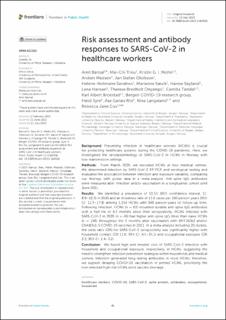Risk assessment and antibody responses to SARS-CoV-2 in healthcare workers
Bansal, Amit; Trieu, Mai Chi; Mohn, Kristin Greve-Isdahl; Madsen, Anders; Olofsson, Jan Stefan; Sandnes, Helene Heitmann; Sævik, Marianne; Søyland, Hanne; Hansen, Lena; Onyango, Therese Bredholt; Tøndel, Camilla; Brokstad, Karl Albert; Syre, Heidi; Riis, Åse Garløv; Langeland, Nina; Cox, Rebecca Jane
Journal article, Peer reviewed
Published version

Åpne
Permanent lenke
https://hdl.handle.net/11250/3105616Utgivelsesdato
2023Metadata
Vis full innførselSamlinger
- Department of Clinical Science [2318]
- Registrations from Cristin [9791]
Sammendrag
Background: Preventing infection in healthcare workers (HCWs) is crucial for protecting healthcare systems during the COVID-19 pandemic. Here, we investigated the seroepidemiology of SARS-CoV-2 in HCWs in Norway with low-transmission settings.
Methods: From March 2020, we recruited HCWs at four medical centres. We determined infection by SARS-CoV-2 RT-PCR and serological testing and evaluated the association between infection and exposure variables, comparing our findings with global data in a meta-analysis. Anti-spike IgG antibodies were measured after infection and/or vaccination in a longitudinal cohort until June 2021.
Results: We identified a prevalence of 10.5% (95% confidence interval, CI: 8.8–12.3) in 2020 and an incidence rate of 15.0 cases per 100 person-years (95% CI: 12.5–17.8) among 1,214 HCWs with 848 person-years of follow-up time. Following infection, HCWs (n = 63) mounted durable anti-spike IgG antibodies with a half-life of 4.3 months since their seropositivity. HCWs infected with SARS-CoV-2 in 2020 (n = 46) had higher anti-spike IgG titres than naive HCWs (n = 186) throughout the 5 months after vaccination with BNT162b2 and/or ChAdOx1-S COVID-19 vaccines in 2021. In a meta-analysis including 20 studies, the odds ratio (OR) for SARS-CoV-2 seropositivity was significantly higher with household contact (OR 12.6; 95% CI: 4.5–35.1) and occupational exposure (OR 2.2; 95% CI: 1.4–3.2).
Conclusion: We found high and modest risks of SARS-CoV-2 infection with household and occupational exposure, respectively, in HCWs, suggesting the need to strengthen infection prevention strategies within households and medical centres. Infection generated long-lasting antibodies in most HCWs; therefore, we support delaying COVID-19 vaccination in primed HCWs, prioritising the non-infected high-risk HCWs amid vaccine shortage.
